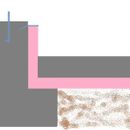Keeping Crawlspace Dry During Construction
Hi, I am in zone 4a.
Trying to figure out how to prevent conditioned crawlspace from becoming swimming pool while under construction and after completion of house?
Since I am building by myself and not a pro carpenter, I am very slow; so, I will probably have some heavy downpours between footer and rat slab, and between foundation and dried in shell.
Also, as I consider any possible plumbing flood that might happen years down the road, what is good practice to prevent a subterranean lake under house?
Thanks for any advice.
-Mike
GBA Detail Library
A collection of one thousand construction details organized by climate and house part










Replies
Mike,
If you can ensure that the grade funnels the water slightly to a corner or side, I'd just run a french drain around the perimeter into a catch basin, and pump it out. If you have temporary power, or a small solar charger + battery system, you can run a pump for a pretty good time before the battery would drain.
Something like this, with a solar charger
https://www.zoellerpumps.com/product/aquanot-spin-508/
During construction, tent the space. Get some suitable polyethylene sheet and put it over the unfinished floor above. The tricky part is if you don't have a floor yet, that poly is going to act like a big pool liner, so you need to temporarily support it so that the water will run off and not pool in it. You can build a simple "ridge beam without a roof" type of arrangement to do that, using a few ropes for extra support. You'll probably still get some water in though, so you might want to have a small pump available. You can get sump pump style pumps that connect to a garden hose for use as a discharge pipe, these work well for temporary use to drain a flooded space. Little Giant is one possible manufacturer of such a pump.
Once your project is complete, you shouldn't have water issues in the crawl space. If you're worried about pipes bursting, you'll want to pitch the floor towards a drain. It's possible to just put a regular floor drain in and seal that into the crawl space liner. A perimeter drain is probably more than is needed unless you're expecting potentially large amounts of water, or frequent issues with water.
Bill
Pitch the floor to a floor drain that runs to open air, or to a sump pit with a sump pump.
Some water in the crawl during construction from rain will not be a big deal, it happens all the time. This type of wetting can be taken care of by running fans in the crawl for several weeks after the roof is on, this will dry it out.
The bigger issue is designing so that water does not get in after the house it is built, this means proper foundation drainage, damp proofing, and grading.
As stated above, installing a sump in the crawl floor is good insurance for future flooding, but it must be installed so that it is part of the continuous air barrier to protect against radon and other soil gasses.